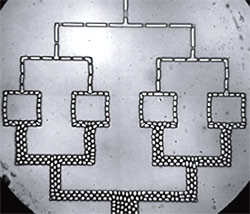Breaking Up Isn’t Hard To Do

Playing with drops of water may seem like a childish pursuit, but it can provide scientific results, too. In the 6 February issue of PRL, researchers describe how they split tiny droplets of water into even smaller droplets of precisely reproducible size, using a method so simple it almost qualifies as child’s play. They sent flows of droplets in single file through micrometer-scale networks of channels containing T-shaped connections. The technique might be used in future devices that automate biochemical reactions with the fluidic equivalent of computer chips.
The ability to make small fluid droplets underlies a wide range of applications, from the manufacture of “scratch’n’sniff” coatings to the delivery of minute amounts of reagents in chemical reactions. Droplets have been made by forcing liquids through pinhole apertures or microscopic gratings, and by combining fine streams of immiscible (non-mixing) liquids. But droplets made by such methods are of a single fixed size. To achieve greater versatility, researchers would like to first create the droplets, then adjust their sizes, and finally create controlled populations of droplets containing several different sizes mixed together.
David Weitz’s team at Harvard University created droplets of water in hexadecane and directed the stream down a 30-micrometer-wide channel. The channel led into the central arm of a T-shaped intersection called a T-junction. At high flow rates, each droplet was torn in two at the intersection, so that smaller drops proceeded outward along the two side arms.
The team discovered they could split the droplets into different but precisely controlled sizes by varying the T-junction’s dimensions. The T’s narrow, outgoing arms flared out and became much wider at some distance from the T; the shorter this distance, the faster the fluid flowed. So if the arms were different lengths, the shorter, faster-flowing arm took a larger fraction of each incoming water droplet. This result was “absolutely a surprise,” says Weitz.
Passing a stream of water droplets through a symmetric T-junction and recombining the outflows creates a population of droplets half the size of the original. By repeating this process, the researchers were able to create droplets one quarter the original size, one eighth, and so on. To create a population of droplets with some prescribed range of sizes, on the other hand, one could construct a hierarchy of unequal T-junctions, each breaking droplets into chosen fractions, says Weitz.
The Harvard researchers also broke up water drops by passing them down a channel containing a square obstacle, placed either centrally or to one side. Flow around the obstacle tore the drops into smaller droplets, although the results were not quite as tidy as the T-junction work.
“Kinda cute,” is how Stephen Quake of the California Institute of Technology in Pasadena describes these techniques, although he is not so surprised at the consistency of the results, since flow in these experiments is free of turbulence. Weitz says his team has no particular application in mind for their new technique, although it adds to the growing repertoire of microfluidic methods. Both he and Quake say that the ability to deliver tiny and precise quantities of reagents is of crucial importance for “lab-on-a-chip” technology of the future, in which micrometer scale devices would perform multiple chemical analyses, such as in genetic screening.
–David Lindley
David Lindley is a freelance science writer in Alexandria, Virginia.


